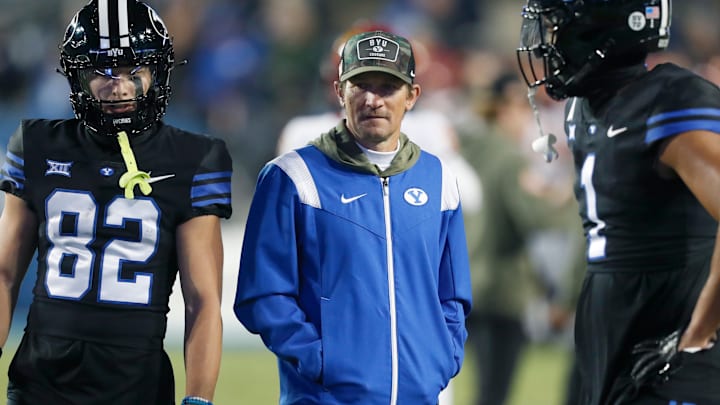As BYU enters Big 12 play this weekend with a 3-0 record, there’s a guarded optimism among Cougar fans that Kalani Sitake’s squad can get at least three conference wins and make a bowl game this year. While there’s understandable wariness about Jake Retzlaff’s turnovers and a banged-up running back room, those aren’t the Achilles heels that could derail a promising season.
Here’s the potential derailer that could lead to a massively disappointing stretch against Big 12 opponents:
BYU cannot consistently convert on third-and-short.
By “third-and-short” I mean situations when there are three yards or less separating BYU’s offense from a first down.

The Worrisome Third Down Statistics
Most BYU fans already know third down conversions as a whole have been underwhelming thus far. Through three games the Cougars offense has converted just 11-of-39 (28%) of the third downs they’ve faced. That’s not good.
But not all third downs are created equal. It’s one thing to not convert on third-and-9. It’s something completely different when a team can’t get a first down on third-and-2, and that’s where BYU’s offense is coming up short this season.
Through three games the Cougars are just 4-of-12 (33%) when facing third down with three yards or less remaining. That, my friends, is alarming given the quality of defenses BYU has faced thus far when compared to the opponents they’ll be facing in the Big 12.
What’s more, of the eight third-and-short failures there have been six rushing attempts that have gained a total of just three yards, or 0.5 yards per carry. When passing on third down fails, Jake Retzlaff is 1-of-2 for one yard.
Woof.

The Need for a Healthy LJ Martin
LJ Martin is without question BYU’s best running back. He’s also the cure to what ails BYU’s anemic third down production.
Martin’s combination of vision, power, and speed is unmatched by any other running back on the roster. LJ, simply put, is a stud and if he could remain healthy would be a candidate for a 1,000-plus yard season. If BYU’s going to succeed in the Big 12 this year, they’re going to need a healthy LJ Martin navigating and bulldozing his way through the line on third downs.
In the games in which he has played this year, Martin has three carries in third-and-short situations with two of them resulting in first downs. Against Southern Illinois he gained four yards on a third-and-3 then later in the game picked up three yards on a third-and-2.
Those two LJ Martin runs constitute half of BYU’s third-and-short conversions this year.
Hinckley Ropati, the number two running back, has converted just one of three third-and-short opportunities this year. Freshman Pokaiaua Haunga converted his only third-and-short by gaining 10 yards on a third-and-1.
Quarterback Jake Retzlaff is 0-for-3 in third-and-short territory with an incomplete pass, a complete pass that was short of the sticks, and a run that was stuffed for no gain. Offensive Coordinator Aaron Roderick has a mobile quarterback with a live arm and needs to figure out a way to more productively utilize Retzlaff’s dual-threat ability.
It’s noteworthy to point out running back Miles Davis has not had a single touch in third-and-short territory this year, likely signifying the coaching staff’s lack of trust with him running between the tackles.
If BYU is going to convert on third down, they either need a healthy LJ Martin or for Aaron Roderick to get much more effective in schemes, designs, and play calling. Running between the tackles from pistol formation behind a sliding offensive line trying to zone block hasn’t been successful thus far, and the responsibility lies with Roderick.

The “We’ll Just Go For It on Fourth Down” Fallacy
One of the troubling narratives coming from Kalani Sitake, Aaron Roderick, and BYU players this season is they appear to be unfazed by their third down futility. Based on what they’re telling the media it sounds like they’re generally okay with failing on third down because their mindset is to be aggressive and go for it on fourth.
That’s a recipe for disaster in Big 12 play.
As stated earlier, not every third down is created equal. If BYU turns a third-and-10 into a fourth-and-2, then, sure, go for it!
But the problem is the Cougars are just 4-of-12 in third-and-short situations this year. Whether it’s third down or fourth, BYU just can’t seem to consistently grind positive plays in those downs and distances.
Turning a third-and-3 into a fourth-and-2 then going for it on fourth is living in the danger zone against Big 12 competition. It’s one thing to convert on fourth-and-short against SIU and Wyoming. It’s something completely different to do the same against Utah, Kansas State, and Oklahoma State.
BYU’s coaching staff shouldn’t make justifications for their offense turning “third-and-short” into “fourth-and-shorter”. Aaron Roderick’s offense needs to start converting on third down, period. If the Cougars continue to get stuffed on third-and-short situations in conference play, getting those three elusive wins needed for bowl eligibility is going to be a tall task.
If BYU wants to keep this season’s momentum going, they’re going to need to find some momentum on third-and-short situations.
